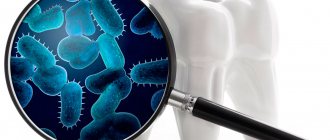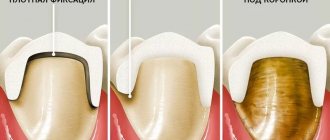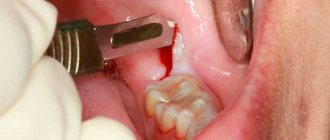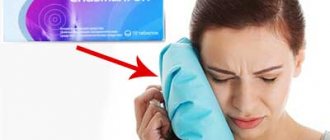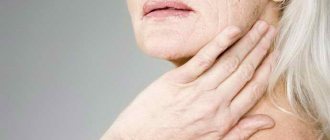Sustavin.ru » Osteochondrosis » Cervical osteochondrosis » Osteochondrosis as a cause of burning tongue
0
4224
Article rating
Pain and burning of the tongue is a common manifestation of cervical osteochondrosis. An unpleasant symptom is associated with damage to the nerves near the oral cavity. Burning of the tongue with cervical osteochondrosis is eliminated with the help of medications, neck stretching and massage.
Osteochondrosis as a cause of burning tongue
What can cause pain in the neck area on the right?
People who have neck pain on the right side often cannot turn their head to the side, up or down, it is difficult for them to sit, and it is uncomfortable to lie down. Inadequate movements impair spatial orientation and activity. Severe pain causes blurred vision and nausea. It can be permanent or temporary, it can appear suddenly and go away on its own after a few days.
If neck pain recurs periodically and does not go away for more than a week, you need to find out why this is happening by consulting a doctor.
Causes of pain
In most cases, pain is a symptom of degenerative changes in the cervical spine, which develop with a sedentary lifestyle and poor posture. But its appearance is also influenced by the following factors:
- hypothermia and draft;
- heavy physical activity;
- uncomfortable head position during sleep;
- stress, emotional outbursts that provoke neurological muscle spasms;
- torticollis - congenital or caused by developmental defects;
- forced immobility of the neck after surgery;
- injury due to an accident, fight, fall, or improper exercise, such as somersaults.
The most dangerous injury is whiplash, which occurs when the head is suddenly thrown back and then forward (or vice versa). This movement can damage the vertebrae, intervertebral discs, ligaments, muscles, nerves and other tissues of the neck. If the facet joints or vertebral discs are injured, the pain can become chronic.
Discomfort on the right can be caused by dysfunction of the following neck structures located on this side:
- arteries;
- veins;
- lymph nodes;
- thyroid gland.
Diseases with characteristic symptoms
Neck pain may spread to the back of the head, head, arm, or back. Depending on the nature of the pain, the following diseases can be suspected:
- Rheumatoid arthritis. There is general stiffness and limited mobility of the neck, and in severe cases, acute pain.
- A hernia in the cervical region and instability of the vertebrae cause severe aching pain in the back, side and shoulder joints of the neck, dizziness, and numbness in the arms.
- Polymyalgia rheumatica. Sharp pain develops rapidly. The disease affects people over 50 years of age.
- Osteochondrosis. Depending on the stage of the disease, the pain may be nagging or stabbing. It spreads along the entire course of the nerve root, extending into the shoulder and arm.
- Cervicago (cervical lumbago). Acute pain occurs suddenly with sudden movement and intensifies with any slight turn of the head.
- Inflammation of the right tonsil.
- Lymphadenitis. A dull pain may occur when swallowing and turning the head.
- Enlargement of the right lobe of the thyroid gland.
- A brain tumor.
- Metastases of cancer of other internal organs (kidneys, breast).
- Myelopathy.
- Subarachnoid hemorrhage.
- Tendinitis, glenohumeral periarthrosis and other pathologies of the shoulder can radiate aching or shooting pain to the neck.
- Retropharyngeal abscess of right-sided localization.
In a preschool child, neck pain may occur due to otitis media. In children under 16 years of age - with juvenile rheumatoid arthritis. If this autoimmune disease is not treated promptly, the lungs and heart will suffer.
Causes of pain development
Conventionally, all causes of neck pain can be divided into groups.
There are different types of violations:
- degenerative changes in the tissues of the spine;
- traumatic damage to cervical structures;
- immune pathologies;
- tumors;
- diseases of an infectious nature.
Osteochondrosis
In the vast majority of cases when the neck hurts, the cause is osteochondrosis.
A degenerative disease causes changes in the spine. The intervertebral discs of the cervical spine are displaced as a result of high loads. Compression of blood vessels and nerves occurs, and a hernia develops. In this case, the pain in the neck is severe and constant. In addition, there are:
- debilitating headaches;
- noise in ears;
- dizziness;
- spread of pain to the shoulder blade, shoulder;
- difficulty moving.
In advanced cases, a narrowing of the spinal cord canal is observed. An obstacle is created to the normal circulation of cerebrospinal fluid. The main reason is osteophytes, pathological bone growths as a result of deforming loads.
If compression of the spinal cord occurs, a person develops weakness and atrophy of the upper limbs.
Injuries
After falls, blows, or improper performance of physical exercises, neck pain can also occur. The most serious injury is considered to be whiplash, in which damage to the cervical spine occurs as a result of sudden flexion and extension.
What types of injuries are typical for:
- road accidents;
- falling on your back;
- fight;
- sudden loads in sports.
If the cause of severe pain is a sprain, there is no great danger. The damage goes away on its own within a few days. But when the vertebral joints are injured, the problem most often becomes chronic.
Sharp pain that occurs after sleeping in an uncomfortable position or during monotonous physical activity is also considered traumatic. In this case, the pain syndrome is felt as a muscle spasm. It is enough to wait a while, change activities, and use a warming rub.
Immune pathologies
Arthritis is a progressive autoimmune disease that, among other structures, affects the spine in the cervical region. In this case, another symptom is added to the general stiffness of poor mobility - pain in the back of the neck.
Another systemic disease is polymyalgia rheumatica. It is expressed in morning stiffness, sharp pain in the back and neck when trying to turn on one side or get up from a lying position. In addition, a person experiences muscle weakness, appetite disturbances, weight loss, depression, and swelling of the joints. Even passive movements can cause pain. The disease affects people over 50 years of age.
Tumors
If the neck hurts severely, and a malignant tumor is detected in a person, this means that metastases have spread to the cervical region and affected the spinal nerves. One of the most common cancers is thyroid cancer. It is asymptomatic and is identified by nodular formations in the thyroid gland. Later, the voice changes and the back of the neck hurts. The main treatment method is surgery followed by radioiodine therapy.
Diseases that may cause neck pain
Distorted posture, a passive lifestyle, or, conversely, excessive physical activity most often cause aching pain in the back and neck. But an unpleasant symptom can also arise as a result of acute or chronic infection.
Meningitis
The disease affects the membranes of the spinal cord and brain. It occurs as a result of penetration of pathological microorganisms into the meninges: viruses, bacteria, protozoa.
Clinical manifestations include:
- a sharp rise in temperature;
- vomit;
- headache;
- increased cranial pressure.
What causes neck pain with meningitis? This occurs as a result of constant tension in the neck muscles, a characteristically thrown back head, and possible convulsions. The disease develops quickly and has different variants. With meningococcal infection, you may fall into a coma. Urgent help and medical supervision is required.
Spondylitis
Inflammation of the spine, as a result of which bone tissue is destroyed. Individual segments and departments may be affected. Spondylitis can develop as a result of other infections: tuberculosis, syphilis, gonorrhea. Ankylosing spondylitis is called ankylosing spondylitis. This is a chronic disease localized in the sacral or cervical spine. Damage to the ligamentous apparatus is manifested by stiffness and limited movements. At the same time, the back of the neck, back and head hurt. The pain goes away after moderate movements and a specially selected exercise therapy complex. Treatment is carried out with non-steroidal anti-inflammatory drugs and immunosuppressants.
Angina
In acute tonsillitis, sore throat is one of the main symptoms. But in addition to the tickling, burning sensation, problems with swallowing, the neck can be very painful on the sides and back. It occurs in herpetic, phlegmonous, catarrhal, follicular forms.
At the same time you feel:
- general weakness;
- swollen lymph nodes;
- back and lower back pain;
- fever;
- temperature increase;
- Strong headache.
Treatment is prescribed depending on the clinical manifestations and the pathogen.
Who to contact and how to treat
To find out the causes of pain, you first need to see a therapist. It is important to analyze what actions could cause discomfort, what other symptoms bother you and clearly formulate your complaints. The therapist will give directions for the necessary tests (general blood and urine tests, MRI, ultrasound, etc.) and, depending on their indications, will prescribe treatment himself or refer you to the following specialist:
- neurologist;
- osteopath;
- chiropractor;
- vertebrologist;
- endocrinologist;
- rheumatologist;
- traumatologist
Often, to treat neck pain, physiotherapy is prescribed to stimulate muscle function, improve blood circulation and metabolic processes.
You cannot self-medicate, for example, make warm compresses. So, if the pain is associated with inflammation of the lymph node, this can lead to an abscess. You cannot try to eliminate the problem with analgesics alone.
How to relieve pain
To eliminate acute pain and muscle spasms, the following methods are used:
- blockade at trigger points;
- intramuscular injections;
- taking pills;
- magnetic therapy;
- acupuncture;
- gentle manual therapy techniques (for example, post-isometric relaxation can be used in the subacute and acute period of myofacial pain syndrome);
- phonophoresis (injection of painkillers directly into the problem area using ultrasound).
The following groups of drugs help to quickly eliminate neck pain:
- analgesics (anesthetics);
- non-steroidal anti-inflammatory drugs with an analgesic effect (NSAIDs);
- hormonal (glucocorticoids);
- muscle relaxants (to relieve muscle tension);
- antidepressants;
- improving blood circulation.
The best orthopedic device is considered to be the Chance collar with rigid or soft fixation, which relieves the load on the cervical spine and relieves muscle spasm. For traumatic pain, warming ointments and patches are used. You can apply a dry compress for 20 minutes, doing it like this:
- 3 tbsp. l. heat salt in a frying pan;
- pour it into a cotton sock or onto natural fabric;
- Apply only when the warmth is pleasant to the skin.
If your neck hurts because it’s stiff, take a contrast shower: hot for 20 seconds and cold for 10. Afterwards, rub your neck well.
Treatment
Treatment of pain in the cervical region requires a comprehensive and qualified approach. For this, it is better for the patient to consult a doctor. After a complete diagnosis, the specialist will prescribe a treatment regimen regarding the etiological factor. For increased tension, myositis and muscle spasms, therapy will consist of taking medications and exercise therapy.
All research methods differ in their cost, equipment used and effectiveness. MRI and CT are considered highly informative
The most common groups of medications include:
Neck pain after sleep
- NSAIDs (non-steroidal anti-inflammatory drugs), analgesics and antipyretics are anti-inflammatory, analgesic and antipyretic drugs that are prescribed for inflammation of the neck muscles and severe pain. Medicines are prescribed by a doctor based on contraindications, medical history and individual intolerance of the patient. In most cases, the following drugs are prescribed: Nurofen, Ibuprom, Ketorolac, Nimesulide, Nalbufin and others.
- Muscle relaxants are a group of medications that are prescribed for limited movements, spasms of soft tissues and the inability to turn or tilt the head. Muscle relaxants are prescribed by a doctor and are sold strictly according to a prescription. The most common include: Mydocalm, Sirdalud, Baclofen and others.
- Chondroprotectors are a group of drugs that include chondroitin sulfate, glucosamine and other cartilage tissue substitutes. These components restore the structure of cartilage, participate in the regeneration of joint tissue and the restoration of metabolic processes. The drugs are prescribed for osteochondrosis, intervertebral hernias and other pathologies of the intervertebral discs. Drugs in this group include: Structum, Dona, Piaskledin, Teraflex and others.
- Novocaine or lidocaine blockade. Injection of local anesthetics in combination with steroidal anti-inflammatory drugs allows you to get rid of unpleasant symptoms for a long time.
In addition to medications, the patient is prescribed a set of gymnastic exercises for the neck muscles: anterior, posterior and lateral muscles. It is the treating specialist who selects physical activities and exercises, since a person can harm his health by choosing them on his own. Physiotherapeutic procedures are also prescribed by attending physicians to speed up the healing process.
The following procedures are most often prescribed:
- ultrasonic radiation;
- magnetic influence;
- electrophoresis with novocaine;
- manual therapy;
- acupuncture.
People who suffer from erosive-ulcerative disease are prohibited from taking non-steroidal anti-inflammatory drugs, as they negatively affect the mucous membranes of the stomach and duodenum.
Preventive measures
To prevent neck pain, improve blood flow, and also after a course of treatment, it is important to follow these recommendations:
- choose an orthopedic mattress and pillow for the correct body position during sleep;
- sit up straight, without tilting your head or throwing it back;
- do not make sudden movements of the neck and head;
- monitor your posture while walking;
- wear the Chance collar for as long as the doctor prescribed;
- keep your neck warm;
- get rid of excess weight.
Massage of the collar area is useful - 2-3 courses per year, incl. point, which is used for migraines and pain in the back of the head. You can learn the technique of stroking and kneading and do self-massage. If you have a sedentary job, breaks to warm up are necessary.
Simple and effective exercises for the neck:
- Bend the body alternately in 4 directions.
- Torso turns with arms extended forward.
- Swing your arms up and down.
- Slow circular movements of the head.
Physiotherapists select therapeutic exercises, which can be dynamic, static, isometric, aimed at mobility of the thoracic region and shoulder girdle. A professionally compiled complex will improve the health of the cervical vertebrae, normalize blood pressure, metabolism, and improve joint mobility.
The main rule: a gradual step-by-step transition from simple to more complex exercises. Exercise should become your habit.
During the day, you can perform a set of exercises based on tension in the neck muscles while they are immobilized:
- Press your forehead onto your palm, then the back of your head. At the same time, the head and arms should not move.
- Keeping your head straight, press the palm of your hand with your right and then your left temple, then your chin.
- Slowly lift your chin up as far as possible, then down, left and right.
Do each exercise 5 times. But if you feel discomfort, do not tilt your head in the direction where it hurts. Feeling better after 2-3 weeks of regular exercise.
Nature of pain
Patients note that pain in the tongue can be local or total, spreading to the entire oral cavity, including the cheeks and lips. One of the causes of numbness in the tip of the tongue is osteochondrosis. If the symptom is single, there is an acute lack of vitamin B12 in the body. Signs of an oral reaction:
- Burning sensation on the gums and throat.
- The root of the tongue and lower jaw become numb.
- The middle of the organ goes numb with a feeling of heartburn.
- Numbness of the entire tongue with cervical localization of the pathology.
- When the nerves are compressed, the organ swells and does not articulate.
- Pharyngeal migraine, sensation of a lump in the throat, dry cough.
- Neuralgia of the glossopharyngeal nerve develops.
- Tingling of the tip, tingling, sensation of “goosebumps”.
Why does my tongue burn? This is a reaction to severe damage to nerve endings. At the same time, the external oral cavity and palate do not change color, do not acquire plaque, or swell.
Associated symptoms include pain in the occipital and cervical region, frequent migraines, loss of elasticity in the muscles of the upper limbs and shoulder girdle, ringing in the ears, tingling in the fingers, vision problems, muscle tension and tissue swelling.
At the last stage, fatigue, fatigue and unstable blood pressure are observed. Can the tongue pinch with osteochondrosis? Yes - tingling, tingling, burning can signal the development of spinal pathology.
Causes of neck pain on the right
Doctors identify several causes of discomfort in the cervical spine:
- intervertebral hernia in the neck, characterized by sharp painful sensations. It involves compression of nerve endings, spreading discomfort to the shoulders and upper extremities. A hernia is accompanied by a decrease in strength and sensitivity of the skin. As the disease progresses, the pain syndrome intensifies. In severe cases, it provokes complete immobilization;
- cervical osteochondrosis, characterized by a decrease in the discs between the vertebrae and the formation of bone processes. Accompanied by attacks of dizziness, impaired sensitivity in the affected area. Pain in the neck area on the right increases when rotating the head;
- spondyloarthrosis involves damage to the articular tissues between the vertebrae. Accompanied by painful sensations of a dull nature. Discomfort increases with physical activity. The syndrome extends to the upper limb and scapula;
- Osteoarthritis is characterized by a sudden onset and rapid rate of development. Painful sensations progress over a short period of time and radiate to the occipital region. As the disease progresses, doctors note numbness in the patient’s neck and loss of coordination;
- cervical spondylosis implies a degenerative-dystrophic process. Painful sensations spread to the back of the head. Accompanied by fainting, tension in the muscle tissue of the neck, numbness of the skin;
- Neuralgia of the occipital nerve ending implies the spread of pain from the right side of the neck to the collarbone. Visual discomfort may occur. Develops with physical damage, infectious diseases, hypothermia, overload of the muscles of the neck and shoulders;
- spinal cord canal stenosis involves compression of the organ due to the growth of bone spines. When the spinal cord is damaged, painful sensations are accompanied by numbness of the upper and lower extremities;
- retropharyngeal abscess involves the formation of small spherical formations on the wall of the nasopharynx. Accompanied by pain in the right neck, increased body temperature, and a change in voice. Discomfort increases when swallowing;
- arthritis;
- inflammatory process of the soft tissues of the neck, characterized by muscle weakness. In addition to pain, it is accompanied by respiratory dysfunction, hiccups;
- The purulent process, in addition to painful sensations, is accompanied by swelling, itching, and redness of the skin. The disease involves purulent compactions:
- tumors of a benign or malignant type, accompanied by a sore throat, difficulty breathing, and a nasal tone of voice;
- emotional stress, depressive syndrome;
- acute form of thyroiditis, the disease is explained by damage to the thyroid gland. Characterized by intense pain, elevated body temperature, attacks of dizziness, nausea;
- poor posture;
- sedentary lifestyle;
- physical damage to the spine;
- aching painful sensations progress with intense physical activity, for example when carrying heavy objects;
- crooked neck syndrome involves tilting to one side. Accompanied by discomfort and constant tension of muscle tissue;
- inflammatory process of the membranes of the brain. Pain in the right part of the cervical spine occurs suddenly, fainting is possible;
- muscle spasm, accompanied by a nagging pain syndrome. Develops during hypothermia.
The most common causes of pain in the neck spine
Almost every person in his life experiences discomfort in the cervical spine.
If there are no physical deformations or degenerative lesions of the ridge, then unpleasant sensations are usually associated with pressure changes, meteorological sensitivity, hyperthermia against the background of ARVI (due to muscle pain), with nervous and physical overload, and emotional stress. If a person spends a long time in a sitting position or engages in strenuous sports, then over time the resulting pain in the neck will become a sign of hypertonicity of the muscles of the neck and trapezius. Over time, such conditions develop into osteochondrosis. Frequent muscle pain is associated with overload of the cervical vertebrae. Compared to other vertebrae, the cervical spine is quite fragile, and the intervertebral discs are small. For this reason, the neck muscles experience greater stress, which leads to their soreness.
Nerve trunks pass through the cervical region, transmitting signals from the brain to the body. The nerve plexus of the neck consists of motor and sensory neuron endings. The cervical region provides innervation to the diaphragm, abdominal region and chest. Therefore, even the slightest damage to the neck is fraught with disruption of innervation. Severe pain also occurs when large vessels are pressed.
What diseases of the spine are most often diagnosed:
- Cervical myositis.
- Protrusions, hernias or osteochondrosis.
- Oncological diseases, tumors of various origins.
- Autoimmune diseases – rheumatoid arthritis, various forms of rheumatism.
- Injuries or sprains, muscle strains.
- Spondylosis, spondylolisthesis.
- Vertebral artery syndrome.
- Ankylosing spondylitis.
If the neck hurts in the front, this may indicate problems with the thyroid gland, inflammation, enlarged lymph nodes, the development of tumor processes, or an aneurysm. Pain in the back of the neck indicates various pathological changes in the spine, inflammation or muscle strain, injury, or damage to the arteries by atherosclerotic plaques.
Signs of cervical osteochondrosis
Typically, an exacerbation occurs in two cases - the morning after waking up or with prolonged static stress. An example is sitting at a computer in a stationary or antalgic position for several hours. When sleeping, a person may lie on their neck or use uncomfortable pillows, which will lead to a feeling of stiffness in the morning. As a result, a strong muscle spasm occurs, causing discomfort.
What contributes to exacerbation:
- hypothermia;
- injuries, damage, sprains, sudden turns of the head;
- nervous or physical stress;
- incorrect work of the massage therapist.
How does cervical osteochondrosis manifest:
- The first sign is discomfort, pain in the cervical region. If osteochondrosis is in the initial stage, then the discomfort is aching and dull, without sudden deterioration. In a calm and relaxed state, problems do not arise, but with a long stay in the antalgic position, an attack of exacerbation occurs. After relaxation, the unpleasant sensations disappear again. If you do not see a doctor at this stage, the disease begins to progress more severely.
- Over time, pinching of the nerve endings of the spinal cord appears, unpleasant sensations arise in the shoulder blade, back, collarbone, and lumbago is felt. As the disease progresses, acute pain becomes chronic. Discomfort is constantly felt in the cervical region. There is irradiation into the thoracic region, and severe headaches are observed.
- Chronic tension headaches plague the patient mainly at night and intensify after physical exertion. Initially, the pain is easily relieved with NSAIDs and analgesics. Over time, the unpleasant sensations intensify, and a feeling of heaviness and fullness arises.
- Spasm when swallowing, pain in facial muscles. The condition is associated with increased osteochondrosis and disruption of normal muscle tone.
Signs of progress of osteochondrosis:
- Constant feeling of tension in the head and neck.
- Problems with neck mobility.
- Ringing, noise, squeaking sensation in the ears.
- Headache from the spine is accompanied by dizziness.
- The patient's performance is greatly reduced.
- Problems concentrating.
- The occurrence of numbness of the tongue and lower jaw.
Signs of overexertion and injury
If the patient has not been diagnosed with osteochondrosis, but pain in the neck continues to bother him after prolonged sitting, then this indicates an overload of the muscles of the neck and trapezius. Usually the pain spreads lower, affecting the area of the shoulder blades. In this case, you need to get up from your workplace every half hour and do a small, gentle stretch. Recommended exercises are turning the head to the sides and circular movements to the right and left. If possible, you should lie down and relax. In extreme cases, warming ointments, massages, a sauna and muscle relaxants will help.
Sprains of muscles and ligaments are more severely painful and are always accompanied by inflammation. Symptoms depend on the degree of damage:
- The pain is insignificant. Acute pain without treatment goes away within a few. Residual – up to 1-2 weeks. Usually therapy is not required in this situation, only rest.
- Stage 2 is characterized by moderate pain and discomfort at the site of injury. For treatment it is necessary to use external painkillers. Acute pain goes away within 2 weeks. The patient is completely cured within a month.
- The third stage is characterized by significant damage to muscles and ligaments. Hematomas, swelling, redness and severe pain are observed at the site of injury. Medical attention and bed rest are required. Severe types of injuries, accompanied by tears, heal within several months. Injectable NSAIDs, ointments and muscle relaxants are usually prescribed.
During the rehabilitation period, the help of a massage therapist, chiropractor or exercise therapy is often required.
Against the background of inflammation, without proper attention to the problem, myositis occurs. The cause of myositis usually lies in both muscle damage and infectious inflammation. The most common cause is exposure to a draft, hypothermia and injury. Patients complain of acute pain in the neck and swelling. Without treatment, the affected muscles spasm, causing the pain to intensify. Therapy is conservative and consists of the use of non-steroidal anti-inflammatory drugs, analgesics and muscle relaxants. During the acute period, it is important to stay warm. If possible, bed rest is recommended.
Pain in the neck spine due to hernia
Pain in the cervical spine is often the result of the formation of a protrusion or hernia. In this area, the ridge has a fragile structure, so this complication often occurs against the background of osteochondrosis or increased stress. A herniated disc in the neck is characterized by discomfort and radiation to other parts of the body. The patient often complains of lumbago from the neck to the head, collarbone, shoulder blade and arm. In the morning, stiffness in neck movements is observed, although there are no inflammatory processes and no damage to muscle or bone structures is observed.
To get rid of pain, you need complex therapy with exercise therapy, massage, medication and a gentle lifestyle. It is impossible to cure a protrusion or hernia in the cervical spine without surgery, but you can slow down the development of the disease by following the principles of conservative therapy. With such a diagnosis, physical activity is strictly dosed.
Pain in the cervical spine due to infection
If the patient feels sharp, throbbing pain in the spinal column of the cervical spine or the back of the head, this very often indicates infection and subsequent inflammation of the soft tissues. Unpleasant sensations are felt constantly. A characteristic sign for diagnosing the disease is a short-term reduction in discomfort after using analgesics or NSAIDs.
Usually the pain is so excruciating that the patient cannot sleep at night. A harmless example of such a disease is aggravated furunculosis on the skin in the cervical region. Worsening is indicated by increased body temperature, fever and hyperhidrosis. Severe diseases that cause similar symptoms are osteomyelitis, epidural abscess.
Pain in the cervical back - deformation of the vertebrae due to spondylosis
This pathology occurs mainly in older people. It is characterized by degenerative changes in the cervical vertebrae, ligaments, bones and discs. At the beginning of the development of the pathological process, deterioration does not occur, but over time, the unpleasant sensations turn into severe pain and bother the patient around the clock. Spondylosis is characterized by ossification of the ligamentous apparatus. Because of this, the patient feels stiffness in the cervical spine, which leads to compression of the nerve endings and arteries.
Associated symptoms - the patient has a severe headache, coordination of movements is impaired, hearing loss or vision deteriorates. Over time, muscle spasms and radiculitis occur. Next, myopathy of the upper shoulder girdle develops, performance is lost, and a feeling of numbness occurs in the body. Treatment methods for pain relief are symptomatic; in case of exacerbation, drug therapy is used. It is preferable to use drugs from the group of muscle relaxants, NSAIDs, and neurotropic vitamins.
Oncology of the cervical spine
Malignant tumors rarely occur in the cervical spine, but metastases in this area are common. Usually the disease is diagnosed in the later stages, when treatment is difficult. Therefore, if you experience the slightest discomfort in the spine, you should definitely contact a specialist. Early research helps to detect cancer at an early stage, which increases the chances of successful treatment.
This type of metastasis (to a specific area) is typical for damage to organs - the stomach, uterus or lungs. The symptoms of the disease are typical, as for many back diseases - at first the discomfort is tolerable, and then the unpleasant symptoms intensify. Possible bone fracture due to tumor growth. The primary cause of oncology is osteogenic sarcoma, leukemia, myeloma.
Narrowing of the spinal canal
This pathology is characterized by pain of varying intensity, with a predominance of pulling, shooting and burning pain. There may also be problems with basic head movements, which is caused by sensory disturbances. Any such failure is fraught with problems with the motor activity of the affected area. There is also numbness in the hands and a sensation of vibration in the affected area.
The pain is burning and squeezing. To alleviate the condition, the patient must lie motionless on his back all day. As the pathology progresses, there is weakness in the arms, a decrease in muscle tone, muscles begin to twitch, and muscle atrophy is observed. When the vessels are compressed, dizziness, a feeling of internal noise in the ears, and fainting are observed.
Referring pain, rare causes of pain
Often, when other systems of the body are affected, reflected discomfort in the neck is observed. With diseases of the trachea, esophagus or throat, discomfort in the cervical spine is sometimes observed. Also, against the background of ARVI and hyperthermia, pain is observed in the muscles of the upper shoulder girdle, which can be felt as pain in the cervical region. Some patients feel mild discomfort, while others complain of severe discomfort. To get rid of pain, you need to cure the disease that provoked the reflected discomfort.
In rare cases, the patient is bothered by the cervical spine for the following reasons:
- Anomalies of ridge development - tropism, hypoplasia of the axis tooth, Klippel-Feil syndrome.
- Metabolic disorders causing degeneration of bone and cartilage tissue, including reactive arthritis, arthrosis.
- Ankylosing spondylitis.
- Spinal tuberculosis.
- Psychogenic disorders.
Types of right neck pain
Depending on the nature of the pain, doctors distinguish the following types:
- shooting, implies a sudden onset of discomfort, develops when the nerve endings of the spinal cord are pinched or irritated;
- pressing, develops when the thyroid gland is malfunctioning or due to an inflammatory process after hypothermia;
- burning, accompanies hormonal imbalances, intervertebral hernias, osteochondrosis, muscle spasms;
- stabbing, progresses with radiculopathy of the cervical roots;
- dull, develops with hypothermia or neuralgia.
Neck pain on the right side: causes and treatment measures
There may be several reasons why your face burns and your head hurts. Such sensations can arise both due to external factors and in the presence of diseases.
External factors include:
- increased physical activity;
- smoking;
- metabolic disease;
- lack of vitamin B;
- pregnancy;
- menopause;
- stressful situations;
- overexcitation of the nervous system;
- sunburn;
- frostbite;
- changes in climatic conditions;
- allergic reactions;
- traumatic injuries.
After drinking alcohol, a person’s cheeks, forehead, nose, and neck turn red. The change in skin color in this case occurs due to increased blood pressure. An alarming situation after drinking alcohol will include the appearance of burgundy spots on the body. This symptom means that the pressure has increased and there is a possibility of a hypertensive crisis.
When your head hurts and your face is red, this may indicate the presence of the following diseases:
- hypertension;
- respiratory disease;
- problems with the heart and blood vessels;
- rosacea;
- neurological disorders;
- sinusitis;
- dental problems;
- migraine;
- vegetative-vascular dystonia.
The main reasons for headaches and numbness in the face include a disorder in the circulatory system of the brain or face, as well as osteochondrosis of the neck. Factors of numbness in the first situation may be aneurysms or capillary blockage. In the second - cervical osteochondrosis. It appears due to salt deposits or pinched nerves in the cervical spine.
When you feel pain on the left side of your head and your cheeks are very hot, these symptoms may be harbingers of a heart attack or stroke. If they occur, you should urgently seek medical help.
Head and face pain may include Frey's syndrome. With this pathology, pain in the ears and temples is pronounced. Discomfort increases while eating and is accompanied by severe sweating, fever and numbness of the face.
Pain in the head and face is accompanied by the following symptoms:
- weakness;
- swelling;
- inflammation of the lymph nodes;
- redness;
- itching;
- noise in ears;
- hemorrhage (in case of injury);
- sweating;
- feeling of heat on the face;
- numbness.
The presence of neurological diseases is indicated by the following symptoms:
- pain arising on one side;
- teak;
- feeling of dryness in the eyes;
- violation of taste buds.
After a traumatic injury to the face and head, the injured part swells. Hemorrhage occurs at the bruised site, swelling and scratches appear. If you have such symptoms, you need to visit a doctor and undergo the necessary examinations to make sure there are no complications after the injury.
As soon as the patient feels pain in the head and face, it is necessary to consult a general practitioner. During the examination, he will clarify the location of the pain and give a referral for examination. If there are specific pathologies, it is necessary to undergo additional consultation with a neurologist, traumatologist or psychologist.
Computer examination methods include:
In addition to the hardware examination, you need to take a general blood test.
After receiving all the research results, the medical specialist will make an accurate diagnosis and prescribe treatment.
Painkillers, antihistamines, sedatives or homeopathic remedies can be prescribed as drug treatment.
If only one half of the head and face hurts, then homeopathic medicines will help to cope with this pathology. Before you begin treatment with these medications, you need to determine on which side the discomfort is felt.
If pain occurs on the right side, treatment is carried out with the help of plants: magnesium muriaticum, iris, sanguinaria or lactuca virosa. If you have a headache on the left, you can get rid of such discomfort with the help of thuja and spigelia.
You can carry out therapeutic measures to eliminate severe redness of the face and pain in the head using traditional medicine. The most effective is a healing mask. To make it, you can use the following recipes:
- Chop two tablespoons of oatmeal. The resulting dry mass is poured with six tablespoons of hot water. Let it sit for about fifteen minutes and apply to the face.
- Carrots are thoroughly washed, grated and used as a mask.
- Take two spoons of grated potatoes and one spoon of olive oil. All ingredients are mixed and applied to the face.
- The zucchini and cucumber are washed, peeled, chopped and combined into a homogeneous mass.
- The banana is peeled, crushed and added to two tablespoons of cottage cheese. Add one spoonful of cream to the resulting mass.
To solve problems with facial redness, fabric masks are often used. To do this, you need to take a clean cloth, moisten it in a medicinal decoction, which can be prepared using chamomile, sage, aloe, cabbage leaf or green tea. The fabric soaked in the healing solution should be placed over the entire surface of the face. Hold until the fabric dries.
To prevent facial redness and headaches from causing discomfort to a person, adhere to the following preventive rules:
- stop using tobacco products and alcohol;
- exclude coffee, tea, spicy and fatty foods from your diet;
- walk outdoors for at least one hour every day;
- avoid stressful situations;
- go to bed at the same time;
- get a full night's rest;
- exercise;
- consume B vitamins;
- Protect your facial skin from exposure to adverse weather conditions.
If your head and face hurt, this cannot be ignored. As soon as discomfort appears, visit your local doctor, undergo the necessary examinations and begin treatment.
When writing the article, the neurologist used the following materials:
- Morozova, Olga Aleksandrovna Headache. Issues of diagnosis, therapy, prevention [Text]: reference guide for general practitioners / O. A. Morozova; Ministry of Health of the Chuvash Republic, . — Cheboksary: GAU DPO “IUV”, 2016
- Aleshina, Natalia Alekseevna Headache: treatment and prevention using traditional and non-traditional methods / N. A. Aleshina. - M: RIPOL classic, 2009. - 253 p. ISBN 978-5-386-01248-9
- Classification of headaches, cranial neuralgia and facial pain and diagnostic criteria for the main types of headache: [Transl. from English] / Classification com. on headaches International. headache islands; [Scient. ed. and ed. preface A. A. Shutov]. - Perm: ALGOS-press, 1997. - 92 p. ISBN 5-88493-017-8
- Uzhegov, Genrikh Nikolaevich Headache: main causes of pain: diagnosis of concomitant diseases: methods of prevention and elimination of headaches / Uzhegov G. N. - M: AST: Stalker, 2005. - 158 p. ISBN 5-17-021078-1
- Osipova V.V. Primary headaches: clinical picture, diagnosis, therapy [Text]: information letter (for neurologists, therapists, general practitioners) / Osipova V.V. [etc.]; Russian Institute for the Study of Headache (ROIGB), Ministry of Health of the Rostov Region, State Budgetary Institution RO “Region. Consultative and Diagnostic Center", Region. Center for diagnosis and treatment of headaches. - Rostov-on-Don: Antey, 2011. - 46 pp. ISBN 978-5-91365-157-0
- Zhulev N. M. Cephalgia. Headache: (diagnosis and treatment): textbook. allowance / N. M. Zhulev [etc.]. - St. Petersburg. : Publishing house. house SPbMAPO, 2005. - 135 p. ISBN 5-98037-048-X
Causes of headaches in the forehead and eyes
Pain in the eyes and head: causes, treatment and prevention
Symptom elimination methods
You can urgently get rid of a burning sensation in your tongue at home. Suitable for this:
- mints, cooling cough drops;
- ice water;
- ice compresses;
- cool teas with chamomile, mint and lemon balm.
Emergency measures provide only a temporary effect. To completely get rid of a symptom, it is necessary to eliminate its cause - pinched nerves by osteochondrosis. The pathology can be cured with the help of medications, therapeutic exercises and massage.
Drug treatment
To eliminate the symptoms of osteochondrosis and restore cartilage tissue, the following is prescribed:
- Painkillers. They relieve pain attacks and relieve swelling.
- Antispasmodics. They relax muscles and reduce pressure on nerves.
- Vasodilators. They strengthen the walls of blood vessels, lower blood pressure, and improve blood circulation in the brain.
- Chondroprotectors. They are involved in the restoration of cartilage tissue of intervertebral discs.
- B vitamins. They improve brain function and participate in metabolic processes.
The complex use of drugs in different dosage forms helps eliminate burning sensation in the oral cavity. The symptom should go away within 2-3 days after the start of drug therapy if it is successful.
Physiotherapy
Exercises for the cervical spine are prescribed in the subacute period of the disease. Severe pain is a contraindication to the use of the method. Therapeutic exercise straightens the spine, relieves muscle spasms, stress on the nerves, and improves blood circulation.
The following exercises are performed at home:
- tilting the head left and right;
- tilting the head forward;
- turning the head left and right;
- rotation of the shoulder joint;
- body tilts back and forth, left and right.
A good remedy for osteochondrosis is hanging on a horizontal bar, exercises with light dumbbells, and a gymnastic band.
You only need to exercise in comfortable clothes. The room should be well ventilated. If pain occurs during exercise, stop exercising.
Massage
Massage sessions of the cervical-collar area act in the same way as physical exercise, but they do not require the expenditure of physical energy from the patient. If your tongue begins to hurt due to osteochondrosis, your neck becomes numb, it is better not to massage at home: inept procedures can put even more pressure on the nerves, then the symptoms will intensify, numbness of part of the face and speech impairment will occur.
To cure cervical osteochondrosis, classic therapeutic, acupressure, vibration massage is used. In physiotherapy, there are methods of influencing painful areas with electric current and acoustic waves. All methods are highly effective, but preference is given to the classical procedure. The course of treatment consists of 15-20 sessions. Symptoms disappear after 3-5 procedures.
Pain in the neck and shoulder on the right back: causes and treatment
The neck is one of the most vulnerable places in the human body due to its mobility.
It consists of seven cervical vertebrae surrounding the spinal cord and forming the spinal canal.
Between the vertebrae there are discs, next to which nerves pass.
The structure of the neck includes veins, arteries, muscles, the thyroid gland, lymph nodes, trachea, larynx and esophagus, as well as many nerve plexuses.
Some diseases affect the tissues of the neck and lead to pain .
The article will discuss the causes of neck pain on the right side .
Spine pathologies
If a person has problems with the spine, he may experience a dull, aching, right-sided pain in the cervical spine. Often intense pain occurs in the morning or during prolonged exercise. There is stiffness of movement, pain radiates to the head, shoulder blade or arm.
Spinal diseases causing neck pain:
- The most common is osteochondrosis, which is a consequence of thinning of bone and cartilage tissue. In addition to the listed symptoms, it is accompanied by paresthesia (numbness, tingling) and dizziness. Painful sensations are caused by nerve endings as they are compressed by the affected cervical vertebrae.
- Osteoarthritis, which is becoming more common every year. In this case, pain in the neck on the right side and in the shoulder occurs due to damaged intervertebral joints. They may spread to the face, back of the head, and ear.
- Herniated intervertebral discs. Pain in the neck occurs due to strong compression of the nerve root and radiates to the shoulder.
- Deformation and traumatic injuries of the cervical spine.
- Spinal stenosis resulting from degenerative changes in the spine associated with overload of the neck. Intense pain is accompanied by weakness in the limbs, convulsions, and loss of sensitivity.
To determine the exact cause of pain, radiography, computer and magnetic resonance imaging of the spine are used.
Causes and nature of pain in the neck on the right side
Neck pain on the right side is an unpleasant symptom that can cause a lot of inconvenience. Sometimes it indicates mechanical problems in the cervical spine, sometimes it indicates the presence of systemic diseases. The nature of the pain depends on the cause that caused it.
It can concentrate in the spine or radiate to the right arm (with radiculopathy).
Often the neck pain becomes very severe. In some cases, it disappears on its own after 1-2 weeks, in others it is observed for a long time (2-3 months).
Neck pain on the right side may be a sign of the following diseases:
- Osteochondrosis and osteoarthrosis . They are the most common culprits of neck pain. Helps reduce intervertebral discs, between which bone tissue grows. If left untreated, certain difficulties arise, for example, the inability to turn the head to the side.
- Cardiovascular diseases . If the pain is concentrated at the back and radiates to the right side, you should visit a cardiologist. This symptom may signal the development of coronary heart disease, angina, cardiosclerosis or myocardial infarction.
- Malignant and benign formations . In oncology, metastases spread throughout the body, and the cervical region is no exception. If you notice pain in the neck (left or right), you need to contact an oncologist to rule out the presence of melanomas, cancerous tumors and thyroid diseases.
- Rheumatoid diseases . If neck pain appears when swallowing and radiates to the back of the head, this may indicate nervous tension caused by depression or chronic stress, or rheumatoid diseases.
- Somatic diseases , diseases of the spinal column, tumors. They are accompanied by severe pain on the right side of the neck, which is localized under the jaw and radiates to the shoulder. Sometimes pain occurs simultaneously in the neck and right ear.
- Kidney and lung diseases . Their presence is indicated by pain in the neck, radiating to the shoulder and accompanied by difficulty turning the head to the sides.
- Complications of sore throat . Pain on the right side of the neck may occur in children who have recently had a sore throat.
Also, the appearance of painful sensations on the right side of the neck is possible with abscesses and intracranial hemorrhages. Even if you are sure that you are healthy, you should consult a doctor to rule out serious life-threatening pathologies .
Other reasons
Other factors that can cause pain on the right side of the neck include:
- Injuries resulting from an accident or incident. Pain caused by injury is characterized by high intensity. Intervertebral hernias often develop as a result of trauma. In this case, the nerve endings are pinched, which leads to throbbing pain in the cervical region, radiating to the arm, head or shoulder.
- Physical strain of the neck muscles . Occurs when staying in an uncomfortable position for a long time or making sudden movements of the head. Sometimes the pain appears in the morning, which may indicate the wrong choice of pillow and/or mattress. Also, muscle strain is possible due to hypothermia and sedentary work (long sitting at a computer or driving a car).
To establish the exact cause of the pain, you need to consult a specialist and undergo an examination.
The connection between unpleasant sensations and SCH
During the development of osteochondrosis of the cervical spine, the cartilage tissue between the discs is destroyed, and the interarticular space narrows. At the same time, the body triggers a replacement reaction so that the spine continues to be maintained in the anatomically correct position. Over time, osteophytes - bone spines - begin to grow at the junction of the vertebrae, which provoke pain.
A bulging intervertebral disc irritates muscles and nerve fibers. This phenomenon provokes pain that radiates to nearby areas.
Discomfortable sensations in the throat with cervical osteochondrosis are often confused with other pathologies that cause similar sensations, and it is possible to determine that a sore throat is associated specifically with the presence of osteochondrosis by specific signs:
- one-sided nature of discomfort;
- pain occurs when eating solid food;
- during a conversation, a foreign object is felt in the throat;
- as the disease progresses, the pain becomes more intense;
- if compression of the nearest blood vessels occurs, signs of hypoxia occur - headaches, dizziness, loss of consciousness.
Can there be discomfort in the throat and why does this happen?
Let's consider whether it can go down the throat with SHOH. As is already clear from the above, a sore throat can occur with cervical osteochondrosis , and usually these sensations are associated with pharyngeal migraine. This is a slightly different sensation than a sore throat due to colds.
As a result of neurovegetative changes that occur due to a degenerative process in the spine, innervation of nerve endings is observed, and the pharyngeal muscles spasm. In this case, the person feels a “lump” in the throat, and may also have difficulty swallowing and breathing.
Additional symptoms of pharyngeal migraine include stabbing pain in the clavicular area when swallowing, swelling of the tongue, numbness of the pharyngeal tonsils and palate, and cardialgia.
Reference! The main differences between a sore throat during colds and infectious diseases and that resulting from cervical osteochondrosis are an increase in temperature, the presence of mucous discharge from the nose, and hyperemia of the nasopharyngeal mucosa.
Associated symptoms
When visiting a doctor, the patient will have to tell the doctor everything that worries him.
Most often, neck pain is accompanied by the following symptoms:
- numbness of the upper extremities;
- the appearance of skin rashes;
- tinnitus;
- increased body temperature;
- loss of consciousness and/or coordination;
- increased intracranial pressure;
- difficulty turning the head to one or both sides;
- vomiting, nausea;
- pain in the neck, radiating to the arm.
Also, before visiting a specialist, it is worth observing the nature of the pain , because... Each patient's neck pain is different. Sometimes the sensations are intense, sometimes they are aching. All symptoms must be described in detail to the doctor.
Symptoms
Clinical symptoms of cervical osteochondrosis are divided into three groups:
- Neurological manifestations - appear as a result of inflammatory processes and changes that occur in tissues and affect the peripheral part of the nervous system.
- Symptoms are associated with the impact of pathology on the spinal cord.
- Signs that depend on disruption of processes in the nerve endings leading to the brain.
As soon as disturbances in the peripheral nervous system begin, the patient experiences pain , they are not always constant, but in any case they begin inside the neck. Despite the fact that they are similar to muscles, relaxation does not occur during a massage.
When the peripheral nervous system is damaged, shortness of breath occurs, a “lump” appears in the throat, and difficulty breathing occurs. The progression of the pathology leads to the spread of symptoms - headaches, dizziness, general weakness, and numbness of the fingers.
It hurts to swallow
Sore throat with cervical osteochondrosis is accompanied by the following clinical picture:
- dryness and sore throat;
- paroxysmal dry cough that provokes nausea;
- suffocation.
Sometimes there is belching of air. When the 4th cervical vertebra is affected, discomfort in the mountain is observed only on one side. The patient has difficulty swallowing, and the pain intensifies when turning the head.
Diagnosis of cervical osteochondrosis only by painful sensations in grief is quite difficult, and therefore pain in the throat must be compared with other signs of spinal pathology. The main distinguishing signs of the presence of cervical osteochondrosis are :
- decreased sensitivity of the parietal region - goosebumps, tingling;
- pain radiating to the arm or collarbone;
- migraine;
- chest discomfort;
- numbness of the shoulders;
- dyspnea.
Dizzy and headache
Dizziness with cervical osteochondrosis is accompanied by the following symptoms:
- Occurs after prolonged sitting - when working at a computer or driving.
- The attacks are aggravated by lying on your side on a soft pillow that does not support the neck well enough in the correct position, as well as by neck movements.
- Dizziness is accompanied by sharp pain in the occipital region; nausea and even vomiting may also occur, which does not bring relief.
- If you press your fingers on the lateral parts of the cervical vertebrae, the dizziness becomes stronger, the feeling of fullness inside the skull increases, and the head becomes “cloudy.”
Several other associated syndromes are associated with dizziness and headaches:
- Posterior cervical sympathetic syndrome – pain occurs after sleep, has a pulsating nature, and is accompanied by dizziness.
- Vestibular-cochlear syndrome – noise in the head, dizziness, hearing impairment.
- Vegetative syndrome – fever, cold extremities, rapid heartbeat.
- Transient ischemia - impaired vision, tactile and motor activity, diplopia, deterioration of the swallowing reflex.
Burning
A burning sensation with cervical osteochondrosis can occur in different areas of the body - in the neck, head and tongue, back, throat. This symptom, like many others, is associated with pinching of blood vessels and poor circulation.
Sore throat with cervical osteochondrosis is often accompanied by a burning sensation of the tongue . It can occur after sleep, eating hot foods, prolonged vertical position, or can be chronic. In most cases, the appearance of the mouth does not change, but sometimes red spots may appear on the tongue. You need to understand that burning and pain in the oral cavity can be a symptom of other pathologies, so it is important to carry out a differential diagnosis.
So, a sore throat may occur with osteochondrosis of the cervical spine. If medications and physical therapy prescribed for the treatment of throat pathologies do not produce positive results, it makes sense to contact a vertebrologist, neurologist or therapist to diagnose osteochondrosis.
Relief of neck pain on the right side
When neck pain occurs, many begin to self-medicate, which is strictly contraindicated. Any discomfort in the spine area is a reason to immediately consult a doctor. The specialist will determine the cause of pain or discomfort in the cervical spine and prescribe the correct course of therapy .
Treatment for neck pain on the right side may be:
- physiotherapeutic;
- medicinal;
- manual;
- surgical;
- using a special neck brace.
Ointments and creams
For severe pain, ointments and creams are sometimes added to oral medications. These remedies have a local effect and can temporarily relieve pain or reduce it somewhat.
Fastum gel
Practice shows that ointments and creams, as an independent method of treatment, are not entirely effective. They work best in combination with other conservative treatments.
Dolobene
The most effective and popular drugs to consider as remedies for neck pain are: Diclofenac, Capsicam, Fastum gel, Voltaren, Finalgel, Finalgon, Chondroxide, Ibuprofen, Ketoprofen, Nise gel, Dolobene gel.
Vertebrogenic causes
Our neck is made up of 7 vertebrae, between which there are 5 discs. The spinal canal contains the spinal cord. In the neck there is a trachea with the esophagus, veins, arteries, muscles, and lymph nodes. Why does neck pain appear on the right side?
Common causes of right neck pain include:
- in being in a non-physiological position;
- stressful situations;
- lifting heavy objects;
- exhausting physical labor.
Pain in the neck on the right is disturbing due to pathologies of the spinal column, destructive changes in articular tissues, somatic diseases, and oncology. Sometimes the right neck hurts due to arthritis. The joint tissue becomes inflamed and wears out. Neurons are also damaged and muscles are strained. Therefore, acute pain, decreased movements when turning the head, and dizziness occur. Pain in the neck area on the right can spread to the collar area and upper limb.
The right side of the head hurts due to osteochondrosis. Dystrophy and degeneration of the discs located between the vertebrae occurs. This pain also radiates to the head, it hurts under the ear, and muscle tissue is overstrained. Pain varies in intensity. Sometimes there is discomfort in the cardiac region. The neck hurts on the right side due to inflamed nerve plexuses formed by the branches of the spinal cord receptors (plexitis).
The neck muscles will become weakened, the pathological process will occur on both sides, or neck pain will appear on the right side. Sometimes the patient will hiccup constantly due to the inflamed phrenic nerve, and breathing will be impaired. The neck hurts on the right side due to a hernia localized between the vertebrae. A sharp pain will appear in the neck and head, radiating to the ear, and there will also be discomfort in the shoulder, at the base of the skull. If you cough, sneeze, or move, the pain syndrome will intensify.
Throbbing pain in the neck may occur due to myalgia. In the neck in front, behind, on the side, every muscle will become spasmodic. Myalgia is considered the result of other pathological processes. The muscles are very painful after heavy physical labor, intoxication, or exposure to cold. The right side of the neck always hurts due to injury, when tendons are torn, muscle tissue is stretched, or due to other injuries. A spasm of myofibers occurs, pain can be of varying intensity.
Common Causes
The anatomical structure of the cervical spine includes muscle tissue, tendons, veins, arteries, and lymph nodes. The pathology of any detail in this complex structure is accompanied by unpleasant sensations in the body. It is possible to understand why the neck hurts on the right side only after a medical examination.
Statistics show that about 85 percent of calls for discomfort in the cervical area are associated with injuries to the spine, for example, disruption of the intervertebral discs. The remaining 15 percent consists of oncological, neurological and infectious problems. Let's take a closer look at the possible reasons why the neck on the right may hurt.
Osteocondritis of the spine
Cervical osteochondrosis is a complex of degenerative-dystrophic disorders affecting the intervertebral discs in the upper part of the spine. This pathology usually manifests itself in the age group over thirty-five years.
Factors causing the disease may be:
- excessive physical activity, lifting heavy weights;
- prolonged stay of the body in uncomfortable positions that place excessive pressure on the spine;
- the patient is overweight;
- spinal injuries, scoliosis, flat feet.
Osteochondrosis is a common cause of neck pain on the right side. Patients suffer from regular back discomfort, aches and numbness in their limbs. The aching pain intensifies with physical activity and sudden movements. Often colored spots appear before the eyes against the background of a throbbing headache.
Occipital neuralgia
A possible cause of pain in the neck and shoulder on the right is occipital neuralgia. A person in this condition may find it difficult to move and turn his head. Pulsating pain discharges are transmitted to the shoulder, scapula and collarbone.
The following causes of pathology are identified::
- hypothermia and colds;
- slipped discs and other upper back injuries;
- excessive tension in the muscles of the neck-shoulder girdle;
- cancer and diabetes.
A distinctive feature of neuralgia is the ability to treat the disease without consequences for the body. But this pathology should not be ignored, since in the absence of medical care, structural changes may begin in the affected nerve.
Types of lymphadenitis
Inflammation of the lymph nodes is expressed by redness and swelling at the site of infection. These symptoms are accompanied by fever and headache, weakness and malaise. Types of lymphadenitis are distinguished by the location of the inflammatory process:
- Cervical - pathology occurs most often due to hypothermia of the body. Additionally, it is necessary to conduct an examination to detect cancer.
- Parotid - in this case, enlarged lymph nodes in the ear area can reach two centimeters. The disease can be triggered by a respiratory viral infection.
- Submandibular - usually a consequence of sinusitis, tonsillitis, caries, periodontitis. Symptoms of the disease include pain in the neck in front of the jaw, swelling and redness of the skin.
Myofascial syndrome
If a person has pain in the neck and shoulder on the right side, this symptom may be a consequence of reflex muscle tension. This dysfunction often occurs due to poor functionality of the intervertebral joints. The causes of the development of myofascial pain syndromes can be :
- increased human weight;
- strong physical activity;
- limited movement;
- scoliosis;
- prolonged exposure to drafts.
Patients suffering from myofascial syndrome may experience tingling and numbness in the fingers, hand and forearm. The source of pain can be localized in the collarbone against the background of swelling in this area. The skin may take on a bluish tint. Unpleasant sensations intensify as a result of hypothermia.
Facet syndrome
Spondyloarthrosis occurs in the process of disruption of the intervertebral discs, resulting in dysfunction of the vertebral joints. The consequence of facet syndrome is the feeling that the patient’s neck is being pulled on the right side.
A concomitant factor in the onset of the disease is often osteochondrosis of the cervical area. Patients experience restriction and stiffness in the upper back.
Acute purulent formations
In the cervical region there are many anatomical formations in which inflammatory processes can occur. As a result, purulent accumulations - abscesses or abscesses - can form. They are divided into the following types:
- Localized on the surface. Occurs due to cuts, scratches or open injuries. If there is a formation in the front, back or side of the neck, it becomes painful for the patient to turn and tilt his head.
- Peritonsillar abscess. The result of the pathology is a purulent inflammatory process near the tonsils. If a person has pain in the front of the neck, a peritonsil abscess is likely to develop. Often the disease is a consequence of sore throat, tonsillitis or pharyngitis.
- Retropharyngeal abscess. Patients with this pathology experience pain in the neck and throat. There is a burning sensation as a result of eating, the temperature rises, and the head hurts. Retropharyngeal abscess can be a complication after influenza, measles or scarlet fever.
Nonvertebrogenic causes
Severe pain on the front, back, side can occur due to other pathological conditions. Internal organs and systems may be affected: suppuration of the retropharyngeal zone, which causes pain when swallowing, inflammation of the cerebral membranes, hyperthyroidism, pneumonia and other pathologies that are accompanied by pain.
Oncological processes in the cervical area also affect the location of pain. The tumor may not be in the cervical region, but the pain pulsates due to metastasis caused by lung cancer or other malignant neoplasms. The front, back, and side of the neck may hurt due to infectious pathologies. If neck pain suddenly appears, radiating to the right, and the cervical area is constantly tense, then you should urgently consult a doctor.
Symptomatic manifestations depend on the cause of the discomfort. Pain syndrome of vertebrogenic origin usually manifests itself on one side, the pain is long-lasting, radiating to the shoulder area, the right upper limb.
The neck becomes stiff, the patient has a headache, and the skin becomes numb. Acute right-sided pain in the cervical area can often signal a traumatic impact. Muscle tissue is in a weakened state due to physical overload and tissue damage.
During infections, a person is worried not only about pain, the right lymph node will become enlarged or the lymph nodes will enlarge on both sides, the neck muscles will be tense, hyperthermia will appear, the head will hurt, and the person will have difficulty breathing.
With oncology, the lymph node will also be enlarged, the neck will hurt, the person will become weak and lose weight. The patient will become apathetic and indifferent to food.
Lymphangitis
Description
A disease that affects blood vessels (capillaries) and lymphatic trunks . Pathologies of the extremities are more common.
It occurs against the background of other inflammatory processes and affects children and adults.
Type of pain
Sharp pain when pressing on the affected area.
Localization
Localized along the lymphatic vessels.
Additional symptoms
Redness of the skin, swelling, increased body temperature, headache, general malaise.
Which doctor treats you?
Vascular surgeon.
Diagnostics
Blood test, visual examination, duplex scanning of blood vessels, computed tomography.
Treatment
Treatment depends on the form of the disease. To relieve pain, non-steroidal anti-inflammatory drugs, antiseptic dressings and therapy with antibacterial drugs are prescribed.
